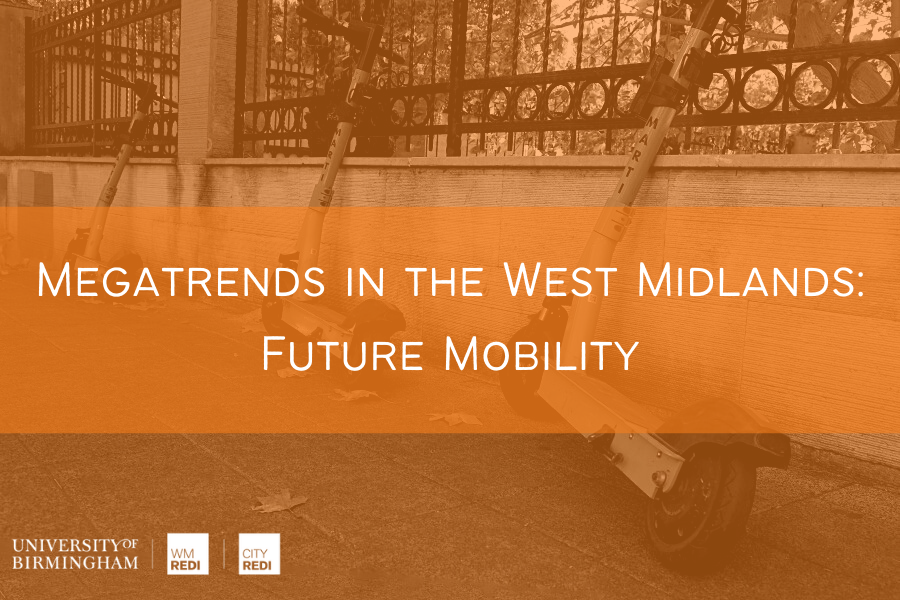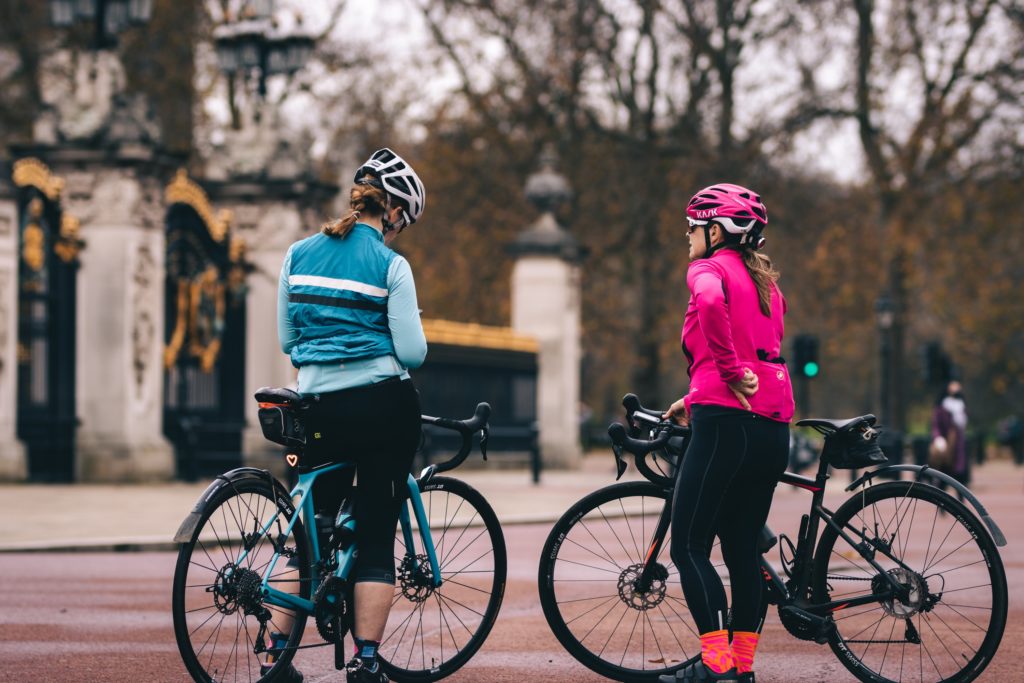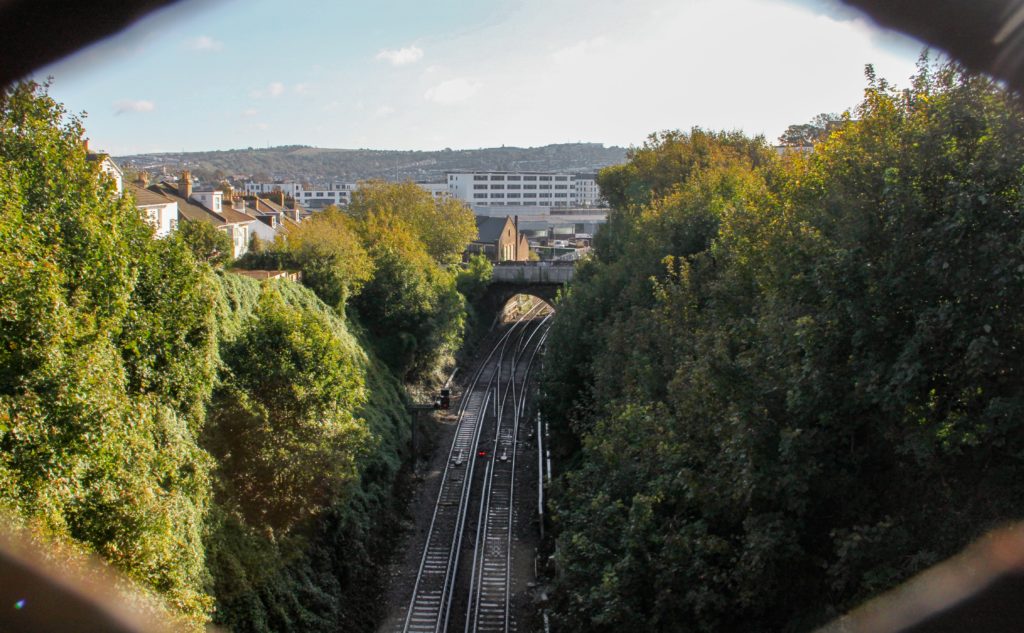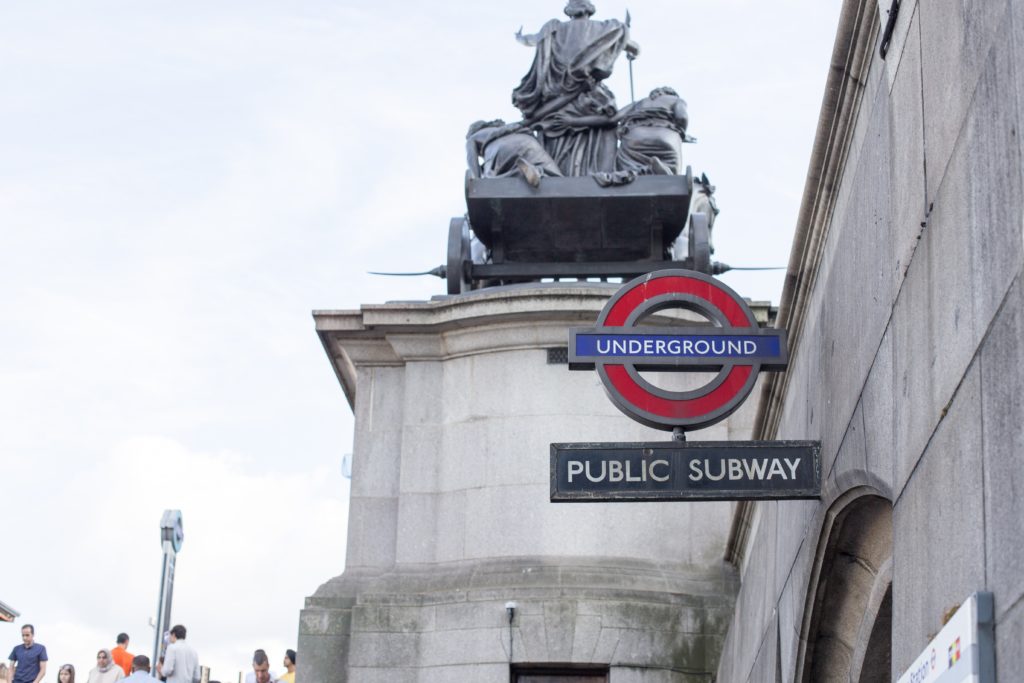
Madga Cepeda-Zorrilla explores future urban mobility and the functioning of places. She considers the challenges for transport from shift to homeworking and hybrid working; the growth in walking and cycling; car ownership, technology and behaviour and safety on public transport. This article is part of larger project looking at Megatrends in the West Midlands. Megatrends are major movements or patterns or trends that are having a transformative impact on business, economy, society, cultures and personal lives. The project examines some of these megatrends in a series of provocations, podcasts and a report. View the full provocation.
Introduction
The Covid-19 pandemic has deeply affected the way that cities function, with a shift of activity away from city centres during the lockdown. This has negatively affected not only the economy but also the social dynamics and people’s health and wellbeing. The lockdowns also led to a reduction in traffic congestion, improved air quality and growth in walking and cycling. This is important because it shows that old problems in the region, such as poor air quality and lack of physical activity could be addressed by adaptations during the Covid crisis.
In the UK according to DEFRA and PHE, poor air quality represented the largest environmental risk to the Public Health system. The UK has air pollutants such as NO2 above the guidelines set by the World Health Organization (DEFRA, 2019). In the UK the NO2 and particulate matter are traffic-related pollutants (Sayegh, et al. 2016); therefore a reduction in car use and a modal shift towards walking and cycling can help to reduce air pollution and in consequence reduce the number of air pollution deaths.
At the international level, different cities are introducing new urban models to address urban planning issues. Post Covid-19 megatrends vary across the cities but all are based on the same principle: inverting the transport planning pyramid and prioritising walking, and cycling (Nieuwenhuijsen, 2020), as well as encouraging the use of public transport rather than private vehicles. This means placing people at the centre of the equation.
This article explores future urban mobility and the functioning of places; it considers the challenges for transport from shift to homeworking and hybrid working; the growth in walking and cycling; car ownership, technology and behaviour and safety on public transport.
Key trends and issues
The shift to remote working and the emptying out of cities
Pre Covid-19, 37.5% of employees in the Netherlands sometimes or usually from home, followed by Luxembourg (30.8%) and Belgium (22.7%) (Walker, A. and Desomer, E. 2020). In the UK the numbers were somewhat lower, but after increasing to over 40% in the first lockdown, they dropped to 36.5% in June 2020 (Felstead and Reuschke, 2020).
Analysis from 20 countries shows that “more than 20 per cent of the workforce could work remotely three to five days a week as effectively as they could if working from an office. This means that if remote working took hold at that level, there would be three to four times as many people working from home than before the pandemic” (Lund et al. 2020).
While remote working can lead to a reduction of demand for transport for travel-to-work, hitting financially transport operators and increasing the risk of job losses, therefore “demands an urgent operational response by the public transport systems” (Wong, 2020), growth in e-commerce (online buying) might have a negative impact on traffic and pollution in as a result of the use of conventional private vehicles for the deliveries (Nieuwenhuijsen, 2020).
Growth in walking and cycling
Walking and cycling have been encouraged by several cities across the world (Combs, 2020) during the Covid-19 pandemic. To accommodate social distancing it has been necessary to reconfigure streets to allow more space for pedestrians: one study (ESRI, 2020) found that “only 30% of Great Britain’s footpaths are at least 3 metres wide, 36% are between 2-3 metres and 34% are less than 2 metres wide”. In the West Midlands, maps of Birmingham show that the city does not have the conditions to provide the minimum distance of separation for pedestrians.
In the UK there has been an encouragement to cycle in order to commute and as a way of exercising. During the lockdown, cycling increased and 17 % of respondents to the Covid 19 travel change survey said they are likely to cycle more post lockdown (WMREDI, 2020). To encourage more cycling, the government allocated funds to improve cycling infrastructure; the Department for Transport announced an investment of £2 billion (part of the previous announcement of £5 million) to improve infrastructure for cycling in 2020.
The importance of growth in walking and cycling goes beyond the coronavirus outbreak. Pre Covid-19, the West Midlands is a region which already had poor health outcomes. Walking and cycling can help to implement more physical activity into people’s lifestyles while commuting and help to reduce the health costs of sedentary lifestyles (Cepeda, 2019). Even a short walk or cycle can have a positive impact on people’s mental and physical health.

Besides health, walking and cycling can have positive effects on the central business districts. Living Streets in the UK, previously evaluated case studies from several English cities to illustrate and predict the economic and social value of pedestrianizing areas. For instance, in 2007 “evaluations of pedestrian improvements in Coventry and Bristol (including pedestrianisation, a new civic square, clearer signage and better placement of street furniture) showed a 25% increase in footfall on Saturdays and predicted £1.4 million benefits respectively” (Living Streets, 2018).
Car ownership
In the UK in 2015 “one-third of households were identified as car-free with the lowest levels of car ownership in urban areas”1 (Living Streets, 2018). On average a car is used only 4% of the time and the rest of the time is parked (Bates and Leibling, 2012). However, street infrastructure is designed to prioritise private cars, and people in a vulnerable situations due to economic barriers, disability, age, sex, or employment status suffer most of the negative effects of private car use (such as air pollution and traffic accidents) (Living Streets, 2018).
During the pandemic, “43 % of public transport users expressed concern about using public transport post lockdown” (WMREDI, 2020). Such concern can lead to a rise in the use of private cars, which are a source of CO2 emissions and affect the zero-emissions target for 2050 set by the government (GOV.UK. 2019).
The pressure over the ambitious target is leading to investment in research and development of electric vehicles (EVs) by private companies, but there is also a requirement for governmental investment in infrastructure to adapt the roads and add public charges. Using EVs provides an excellent opportunity to reduce emissions of Carbon Dioxide and other Greenhouse Gases (GHG) (Jones, et al. 2020) but the encouragement of private EVs will not help to tackle other urban problems such as congestion and social challenges such as physical inactivity. Besides, not everybody will be able to afford these new vehicles (Walker, A. and Desomer, E. 2020).
Safety on public transport
Public transport is essential to society and is essential for some workers (including key workers) to commute to work. However, during a pandemic public transport is considered by some users to be a risky option, especially when services are crowded. In 2020 43% of public transport users expressed concern about using public transport post lockdown” (WMREDI, 2020).

Possible future scenarios
What if we do nothing?
- During lockdown, there were fewer people driving, fewer people using public transport, less traffic congestion, less air pollution and thus better air quality. But with increased home deliveries, there is potential for traffic and pollution from using conventional (petrol and diesel operated) vehicles for the deliveries (.
- Post-lockdown an increase in home/ hybrid working is likely to lead to an increase in social inequalities, given that possibilities for such working arrangements are greatest for highly educated workers in high-skilled jobs (Lund et al. 2020).
Evidence of what works
- Leveraging emerging transport innovations to reduce the long-term impact of CO2 and other vehicle pollutants. New technologies such as drones and robots can help to maintain clean and sanitized public areas and public transport. For instance, drones can spray disinfectants, monitor social distancing behaviour and make public service announcements (ITF, 2020).
- Adopting an approach towards city centres offering services within walking distance can be more open and more green. Hyper-proximity can be a source of new economic and social models in cities (Moreno, 2019). An approach of dense but friendly cities can help to boost the economy since pedestrianised streets can help to encourage shopping in an approach that can translate into a more favourable impact on the well-being of communities. Different approaches include:
- The 15-minute city where “locals are able to access all of their basic essentials at distances that would not take them more than 15 minutes by foot or by bicycle” (Moreno, et al. 2021). One example of this is the city of Paris, where the mayor Anne Hidalgo refers to the “de-concentration” of power to be nearer the citizens and “co-constructions” of initiatives and to move to a more circular economy2 (Power, 2020).
- The 20-minute neighbourhood aims to “give people the ability to meet most of their daily needs within a 20-minute walk from home, with safe cycling and local transport options” (Plan Melbourne, 2020)
- Hyper-proximity is a concept introduced by the cities of Groningen and Utrecht in the Netherlands as well as Copenhagen and Aarhus in Denmark. The concept is based on the idea of “developing social, economic and cultural interactions, of ensuring substantial densification while increasing spaces for public meetings and mixing, travelling by foot or cycling and ensuring that digital technology becomes a factor for social cohesion and inclusion” (Moreno, 2019)
- Compact City refers to a city with “higher densities that are contained and reduce urban sprawl, protect agricultural and amenity land, and make more efficient use of the existing urban land. There is a mixture of uses in close proximity, claimed to encourage sustainable modes of travel such as walking, cycling, and the use of public transport. Environmental, social, and economic benefits are suggested because there would be less dependency on cars and a reduction in GHG emissions. Mixed uses and more people living and working in the same place would give rise to social and cultural vitality, with facilities within easy reach of everybody. Higher densities and the close proximity of a larger population would mean that local businesses become more viable” (Jenks, M. 2019)
- Support for walking and cycling to boost the economy. Previous studies have pointed out that improving walking and cycling can help the economy by providing support to industries such as retail (Littman, 2017). A pre-Covid-19 study by the Mayor’s office in Madrid using data from BBAV Bank found that the increased use of walking and public transport had a positive impact on the businesses in the centre (Ayuntamiento de Madrid, 2019). Although the study only took into consideration three zones of the centre of Madrid, it shows the potential of making more car-free streets.
- Investment and planning for bicycle use. The city of Paris, for instance, has planned to create cycling lanes and make every street in Paris cycling-friendly by 2024 (investing £300m) (Carey, 2020).
- Encouraging people to walk more. Widening the footpaths is likely to positively influence people to walk more in fact; previous research found that pedestrians feel that commuting on foot leaves them vulnerable and at risk of accidents (Hodgson et al., 2004). Although to face the pandemic temporary street transformations happened, in the longer term it is important to plan for a complete reconfiguration of space with pedestrians as a priority.
- Reduction of car use, increase in the use of new technologies such as EVs for commercial use and support for the sharing economy. Possible approaches for reducing car use are:
- Car-Free City, which aims to “reduce unnecessary private motorized traffic and provide easy access to active and public transportation” Analysis of the impact of car-free cities have shown that they can help in reducing air pollution and noise levels, increase the level of physical activity and create space for green areas (Nieuwenhuijsen and Khreis, 2016). An example of this is Vauban in Freiburg, Germany, a neighbourhood without cars and with sustainable housing (Melia, 2006) and the city of Hamburg which plans to be car-free by 2034 (Nuwer, 2014).
- Urban Superblock: the aim of this approach is “to reclaim public space for people, reduce motorized transport, promote sustainable mobility and active lifestyles, provide urban greening and mitigate effects of climate change”. Empirical analysis from the city of Barcelona found that creating superblocks can achieve reductions in air pollutants (NO2); noise, heat and increase in green space and thus reduce the number of premature deaths (Muller, et al. 2020).
- Improving and incentivising the use of Public Transport. In the short term, it is important to keep reinforcing the cleaning patrols until passengers’ perceptions of risk reduction. Post pandemic, in the long term PT might not require the levels of current hygiene but “the demand will be for environments that will enable safety effortlessly” (WMREDI, 2020). This means that shifting to more use of artificial intelligence (AI) and deep learning tools in public transport is important.
- “Automated vehicles (AVs) and Electric Vehicles (EVs) can be put into public transport service. For instance, last year the project by the Future Automated Bus Urban Level Operation System (FABULOS) “demonstrated actual public transport operations using AVs in regular traffic in a variety of locations in Europe” (Schweiger, 2021)
- Adoption of Mobility as a Service (MaaS) and Mobility On Demand (MOD) options can help to allocate demand for transport and help improving mobility. MaaS is based on the use and integration of shared modes of public transport and rideshare systems such as Uber, bike-share and car-share (MAAS.EU. 2020). MOD on the other hand, “consumers access mobility, goods, and services on-demand by dispatching shared modes, courier services, public transport, and other innovative strategies” (Shaheen and Cohen, 2020).

Implications
The ultimate goal of any transport policy is to improve people’s well-being by improving access to important activities. During the COVID19 pandemic, government restrictions o travel have affected more heavily vulnerable people. Hence it is essential to rethink the design of cities is essential to solve old problems and improve people’s well-being. Because as the World Health Organisation manifesto for a recovery from the COVID-19 pandemic has stated, “we cannot go back to the way we did things before” (WHO, 2020).
To achieve healthier, cleaner and economically vibrant cities, is necessary to turn to more psychologically informed approaches to understanding shifting behaviours and values.
Policy recommendations
- Infrastructure is essential but this should go hand in hand with a change in values and behaviour.
- “Local transport authorities to produce plans to permanently reshape local transport networks based on active travel shared and public transport and ensure local authorities and bus operators work together to re-plan bus provision, with better integrated, multi-modal networks” (Better Transport, 2020)
- Increase support and guidance for developing staggered working hours and other measures in order to distribute the demand for transport (HMGOV. 2020)
- Enhance support for individuals and businesses to incentivise mobility start-ups and scale-ups projects (BEIS, 2021) as well as encourage public-private partnerships to revive the hardest-hit sectors and further enable MaaS” (Walker and Desomer, 2020)
- “Redesign the mobility taxation to stimulate alternatives for car: a higher demand for both green and electric vehicle technologies, as well as public transport with attractive first and last-mile solutions” (Walker and Desomer, 2020).
- Re-allocation of street space from cars to cycling and walking in order to realize modal shift and climate ambitions (Walker and Desomer, 2020)
- Strong commitment to academia and research institutes since these “will be critical to economic and social recovery from the impacts of COVID-19” (BEIS, 2021)
This article is part of a larger project looking at Megatrends in the West Midlands. Megatrends are major movements or patterns or trends that are having a transformative impact on business, economy, society, cultures and personal lives. The project examines some of these megatrends in a series of provocations, podcasts and a report.
This blog was written by Dr Magda Cepeda Zorrilla, Research Fellow, City-REDI / WMREDI, University of Birmingham.
Disclaimer:
The views expressed in this analysis post are those of the authors and not necessarily those of City-REDI, WMREDI or the University of Birmingham.
